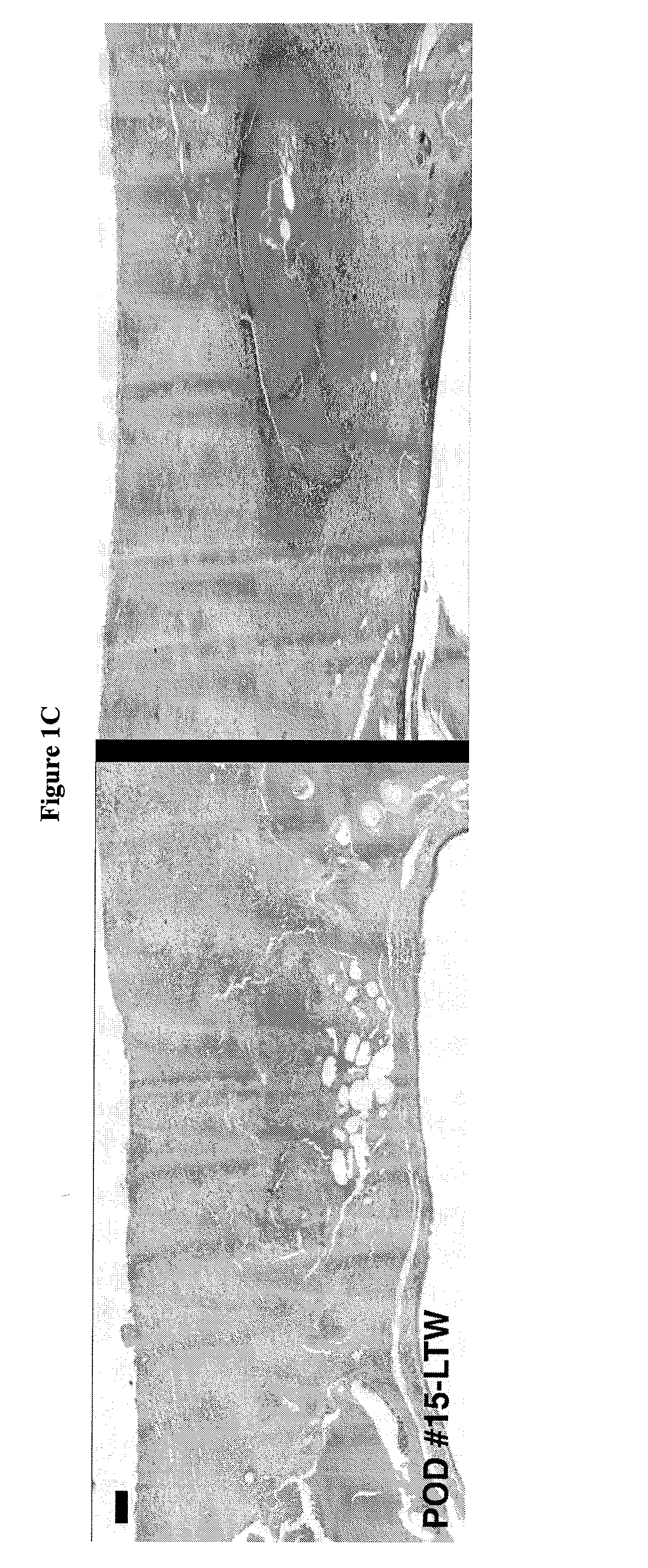Solder formulation and use in tissue welding
a formulation and tissue welding technology, applied in the direction of peptides/protein ingredients, drug compositions, peptides, etc., can solve the problems of difficult to reliably repair endoscopic skull base surgery, tissue defects arising, and limiting factors such as the ability to reliably repair complex defects created
- Summary
- Abstract
- Description
- Claims
- Application Information
AI Technical Summary
Benefits of technology
Problems solved by technology
Method used
Image
Examples
example 1
[0060]Production of Chitosan / Albumin Solder
[0061]Stock solutions:
[0062]1) 0.2 M acetic acid—12.01 g glacial acetic acid+H2O to total of 1 L
[0063]2) 1.3% (w / w) chitosan—Mix 0.327 g of 88-92% DDA Chitosan (Ultrasan CHO2) in 12 mL H2O and 12 mL 0.2 M acetic acid over 36 hours on a rocker.
[0064]3) 71.4% (w / w)—indocyanine green dye (Cardiogreen Sigma). Combine ICG with H2O for 2.5 mg / mL solution. Protect from light with foil.
[0065]4) 29.4% (w / w) albumin solution—Mix 2.5 g into 6 mL albumin. Heat in a 37° C. water bath for 15 minutes and vortex as needed. Centrifuge at 3000 rpm for 3 minutes to remove bubbles.
[0066]Solder Production:
[0067]1) Add 4 cc of the 1.3% chitosan stock solution to a 50 cc beaker over a stir bar,
[0068]2) Add 4 cc of the 29.4% albumin stock solution to the chitsoan solution while stirring, and
[0069]3) Add 2 cc of the indocyanine green dye solution to the mixture.
[0070]4) The solution then precipitates and the supernatant is removed. The gel is aspirated into a 10 cc...
example 2
[0072]This example used the supersaturated gel formulation of Example 1 to evaluate weld burst strength in an explanted rabbit esophagotomy model. A full thickness perforation was created in a rabbit esophagus and following welding, the burst pressure was measured. Using the traditional solder, a burst strength of 71.6 + / −7.5 mmHg was achieved, as demonstrated below in Comparative Example B. However this required tacking sutures to keep the wound from deforming during burst pressure measurement. When the experiment of Comparative Example B was repeated with the present supersaturated gel formulation as the solder, a burst strength of 95.86 + / −8.9 mmHg was achieved and no tacking sutures were required.
[0073]The histologic analysis of the repairs was also quite favorable. No difference was found between overall degree of inflammation and fibroplasia between the laserweld and control groups. This again supports the fact that scar formation may progress unimpeded despite the persistence...
example 5
[0093]In this Example, the solder composition of Example 3 was employed for tracheal repair. The laser system described above was used in this example. Three different types of tracheal repair were undertaken and the results are shown in Table 2 below.
TABLE 2Burst Strength ofInjury With no WeldBurst Strength ofType of Repair(mmHg)Weld (mmHg)Membranous1.72101.00Injury / WeldExcised Cartilage1.6477.34Injury / WeldReplaced Cartilage1.6875.08Injury / Weld
[0094]The results given in Table 2 show that the laser tissue welding materials and methods of the present invention are applicable for a variety of types of tracheal repair.
PUM
| Property | Measurement | Unit |
|---|---|---|
| Temperature | aaaaa | aaaaa |
| Fraction | aaaaa | aaaaa |
| Fraction | aaaaa | aaaaa |
Abstract
Description
Claims
Application Information
 Login to View More
Login to View More - R&D
- Intellectual Property
- Life Sciences
- Materials
- Tech Scout
- Unparalleled Data Quality
- Higher Quality Content
- 60% Fewer Hallucinations
Browse by: Latest US Patents, China's latest patents, Technical Efficacy Thesaurus, Application Domain, Technology Topic, Popular Technical Reports.
© 2025 PatSnap. All rights reserved.Legal|Privacy policy|Modern Slavery Act Transparency Statement|Sitemap|About US| Contact US: help@patsnap.com



